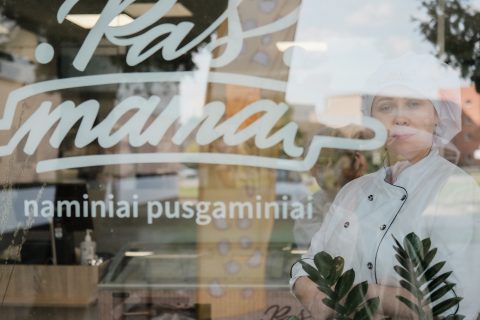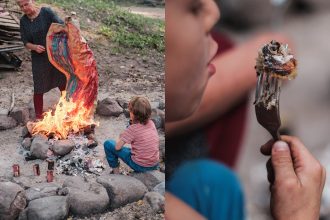Laura Galkinaitė is the author of the culinary blog Bulviukose.lt, who also shares her creations on Facebook groups Grybų receptai (en. Mushroom recipes) and Subproduktų receptai (en. Offal recipes). She has worked in such Kaunas restaurants as Daugirdas and Uoksas, and then opened her hot dog place called ManGi Hot Dogs. A few years ago, a true Kaunas resident moved to the countryside. “We bought a homestead near Druskininkai and at first, we only spent weekends there but as time went on, we kept staying there longer. Finally, we moved our business here. We have become real villagers, although sometimes we do miss the vibes of the city.”

Laura got a tattoo in honor of her grandmother, who made cakes to order. She has a cake recipe on her arm. Inspired by the women in the family, the blogger herself has been cooking since childhood. But why did she name her blog bulvių košė (en. Mashed potatoes)? “Oh, it’s just a random name that my husband came up with. My sister once gave me an internet domain, which was about knitting, and I posted my handicrafts there, and later I started publishing recipes.” The woman says that in the beginning she just wanted to have a recipe book on her computer, because it seemed more convenient and modern than writing in a notebook. But with the increase in traffic and the popularity of social networks, the idea changed.
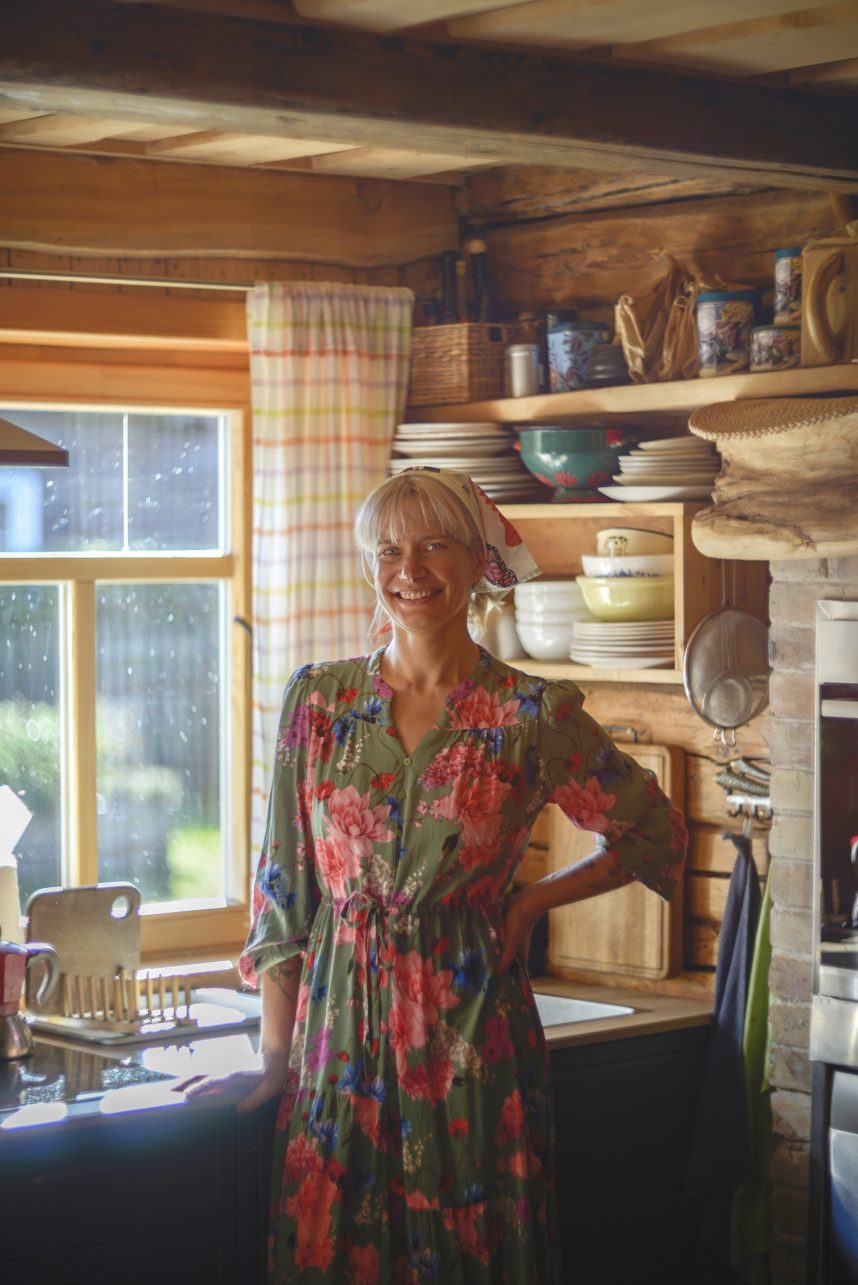
Her first blog post dates back to 2011 and today, the blog already contains almost 1,000 recipes. Who eats that many dishes? Laura laughingly says that she and her husband do. “I don’t like to make the same thing twice; I find it boring.” About half of the recipes in her virtual book are original, the others are borrowed, “I don’t see a problem with taking an authentic recipe and adapting it to my own tastes.” Bulvių košė started with the first wave of food bloggers, just like Nidos receptai and Sezoninė virtuvė. One of Laura’s first favorites was Giedrius Vilpišauskas, blogger turned writer, the author of the book Virtuvės užkariavimo menas (en. The art of kitchen conquest).
Laura is a huge fan of culinary books. “I have a large library of recipe books, from floor to ceiling, but just as others clear out their wardrobes once in a while, I clear out my library from time to time, too. I only keep the most important books.” She prefers thematic books, for example about a particular country or dish. “Let’s say I pick up a book on puddings and study the topic from A to Z.” There are three books on offal in the library, but she doesn’t really like chefs’ books because “they seem to be about everything and nothing at the same time.”
So, offal. The philosophy of sustainability will also help you understand why Laura prefers it. “You have to consume all of the animal, respect it, and not throw any of it away. But there’s another angle – I’m just bored of plain meat. How many ways can you cook that steak? And offal opens a lot of possibilities, the range of flavors is very wide. I recently discovered pig brains in a crust with sweet chili sauce – it’s amazing. It’s these little discoveries that are so exciting.”
We open Laura’s blog and wonder what to cook. Pork: brains, legs, ears, tails, tongues, lungs, kidneys, hearts, heads, fat, flitch, skin, sausages, and soups made from blood. Beef and veal: liver, tongues, brains, tails, lungs, kidneys, hearts, stomachs, tallow, thymus, bone marrow, udder, testicles. Lamb: brains, tails, tongues, lungs, kidneys, hearts, heads, testicles, tallow. Poultry: liver, combs (rooster), legs, skin, tongues (ducks), stomachs, fat, heads (ducks), lungs. Broths are made from the bones of all these animals. Even fish tongues (of cod) can be eaten. We can eat beaver’s tails and moose’s lips.
Laura has to travel from Druskininkai to her native Kaunas to get offal. “Girstupis market is very good. I found some people selling brains there, which are in short supply elsewhere. There is also a central market in Urmas, and they say there is a good section in Zanavykų market. It is not difficult to get offal in Kaunas, for example, I buy pig’s spleen in Norfa. Usually, I just go to Kaunas and come back with a bag of offal, and then the creation begins.”
When reading the recipes, it is easy to notice that the blogger likes to combine different types of meat. “In China, it’s popular to mix like this. Let’s say they cook broths from several types of meat, not many people here make pork broth with chicken bones, although it is very suitable for making soups or sauces. So don’t be afraid to mix it up. On my website you can find combinations such as rabbit with pig tails, pig’s feet with octopus’ legs or beef and oyster pie.”
Even the highest quality meat without anything green (or something that used to be green) will just be meat. To prevent this from happening, Laura created the free digital publication Wild Edible Plants. “At that time, it was popular. My sister and I collected and ate everything, and then we decided to prepare a booklet. Although we planned it as a list of instructions for ourselves, it turned out to be useful for everyone. Although I forage less often now, in spring I always forage for nettles, sorrel and plantain weeds. By the way, the plantain fit very well in an Asian bowl-type recipe: pork tongue snack with plantains and kimchi. It really surprised me; I made it several more times.”
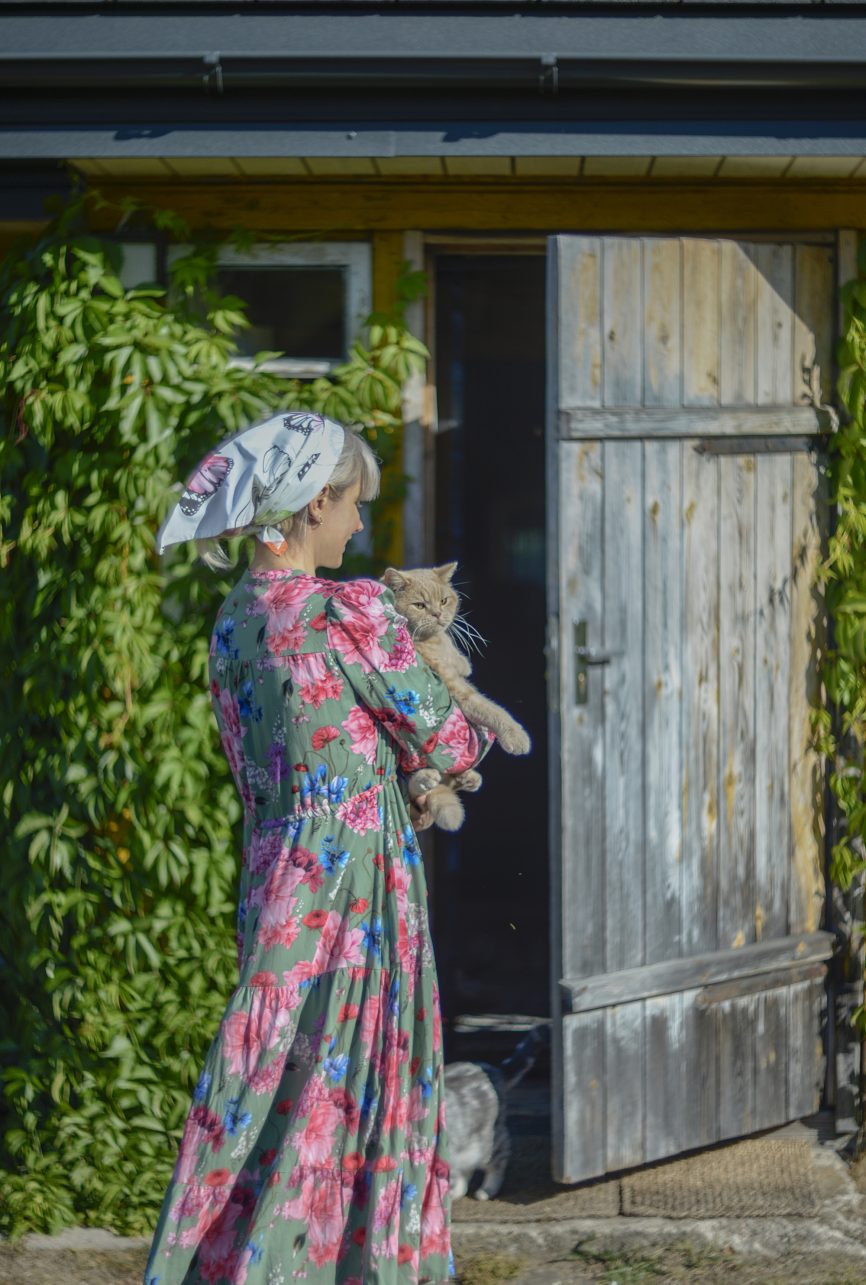
When asked if she misses the routine of restaurants, Laura replies, “I’m cooking meatballs in a pan and I’m happy looking at them, instead of organizing work and dealing with all kinds of paperwork. While working in Uoksas, I followed all kinds of world-famous chefs and trends, but later I realized that it wasn’t for me, and I returned to homemade comfort food. In general, we usually go to restaurants to eat heated food, I prefer to make it at home. Well, OK, not every restaurant is like that…” [laughs].
Laura lives in Dzūkija, and we are having this conversation in autumn, so it’s hard to avoid the topic of mushrooms. However, it is more of her husband’s hobby, “He’s an enthusiast, he likes to discover, recognize, and taste something new. All I have to do is cook and share, but as I mentioned, offal is the most important ingredient for me.” So, would an offal restaurant be successful in Kaunas?
“I don’t think so. When I worked in the restaurant, we tried to offer liver and chicken hearts. There is nothing exotic or modern about it but the visitors, to put it mildly, were not impressed,” the interviewee remembers. For example, in England, offal is valued, you can find fried thymus (this is the thymus gland in the chest, where the bone marrow cells mature), but here you can’t even find it in the market. This is because the British respect their traditions, and in Lithuania, the Soviet occupation somewhat wrecked our gastronomic history. “And later came pizzas and everything foreign. It seems that we haven’t had enough of them yet to this day, although we are slowly starting to return to that real national cuisine that contains more than cepelinai (en. Potato dumplings) and cold beetroot soup.” The cook is critical of today’s popular Scandinavian style of gastronomy, because the desire to emulate it reminds her of an inferiority complex. “Why can’t we stand on the basis of our traditions? Maybe the time will come, and we will grow up.”
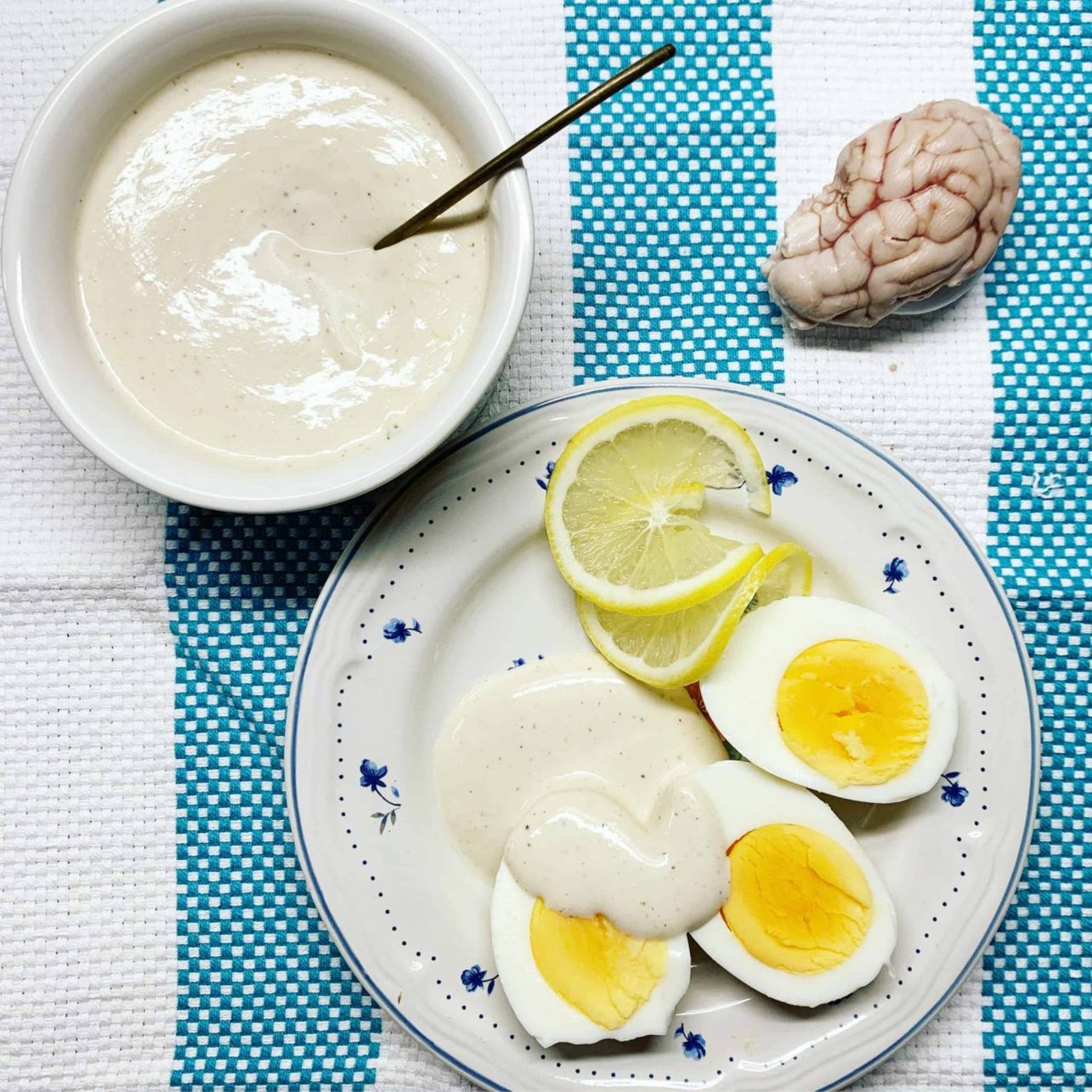
Pork brain mayonnaise
This is a very unusual, mild and savory sauce. The author of the recipe, Chris Cosentino, calls it “brainaise” (from the word hollandaise). It is really very tasty! Since the brain consists of 50 percent fat, they are very suitable for flavoring cold mayonnaise-based sauces. Brainaise goes well with cooked meats, offal dishes, meat rolls, etc.
You will need:
● 1 clove of garlic
● Salt
● 1 large egg yolk
● 1/2 tsp Dijon mustard
● 1/2 cup of neutral flavor oil
● 85 g of boiled pork brain
● Freshly ground pepper
● A splash of lemon juice
For the broth:
● A piece of onion
● A little piece of leek
● Celery stalk
● Lemon peels
● Garlic clove
● Sprig of thyme
● Bay leaf
● A pinch of fennel seeds
● A few grains of black pepper
● A splash of white dry wine
Rinse the pig brains with cold water, put it in a bowl of water and keep it refrigerated for several hours. Once soaked, rinse again. Check for bone fragments. Put all the broth ingredients in a pot with water, add salt. Boil the broth for 10 minutes. Add the brains and cook on the lowest heat, barely simmering, for about 10 minutes. Remove the brain and cool them down. Cooked brains can be frozen.
Add mustard, egg yolk, clove of garlic pressed with a garlic press to a food processor with an S-shaped blade. Turn on the processor until the mass becomes whole.
Slowly add the brains without turning off the processor. When the mass becomes smooth, start adding oil drop by drop. When you see that it is starting to emulsify, you can start pouring the oil in a thin stream. After pouring the oil, season the mayonnaise with salt, pepper and lemon juice.
Brainaise is suitable for use for 2 days. Keep it in the refrigerator.


